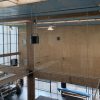
Air movement using fans is normally equated with vertical air flow. You mount the fan on the roof and blow air downwards. The only time one sees horizontal air movement is usually when using pedestal or wall mounted axial fans which are very ineffective at moving air over any sort of distance. They certainly make a lot of noise and use a lot of electricity, but their efficacy is questionable due to their design. Typical axial fans move the large proportion of their air movement parallel to the blades, i.e., sidewards. They can’t project the air very far, which is why they make a lot of noise and spin very fast for not much outcome.
And in many cases the demand for horizontal air flow is not high. Most fans are roof mounted. The general intent is to offer cooling air flow and, in some cases, to also offer winter heating via destratification of the space.
But at Airius we often get sent interesting engineering problems to solve regarding air movement and in some cases, we have suggested horizontal air movement as a cooling or air movement solution.
Classrooms is one example where we wall mount our fans to blow air across or around the space, offering either direct or indirect cooling air movement, depending on what height we mount them and how we angle them in classrooms. Take for example a woodworking classroom; we mounted the fans horizontally but angled and at a height to so they circulate air above head height around the room, pushing air around the room from one fan to another. This meant that the inhabitants were indirectly cooled and there was minimal interaction with the wood working dust laying on the machinery or floors.
This application was also used with one small Airius Opal® fan horizontally mounted above a doorway in small student accommodation rooms. It was angled to circulate the air around the room above head height, providing indirect cooling at low noise, low speed and low cost. That fan uses 11 watts and works very well in that position for those types of rooms, such as hotel rooms etc. And it’s physically a very small fan so its unobtrusive. Great for architectural integrity.
In another example, we have wall mounted our larger fans in sports halls, and angled the fans to ensure a good sweep of the floor. This is applicable where there is not enough head room or height, for example, in a basketball court.

Centrally mounted but angled Airius Model 60 Fans in a sports hall in northern NSW
We place the fans on both sides of the court and space them apart like a zipper, so they don’t counteract the air flow from the fan opposite. This works very well too and solves a lot of issues around clearance and sight lines etc.
We recently designed a solution for a prison exercise yard where there were a range of constraints including external installation with no covering of the fan for safety reasons. It was exposed to the elements. We mounted one of our largest fans horizontally, up high away from any risk from prisoners, and it will almost sweep the exercise yard due to its power and spread, despite being a fixed mount unit. We had to play around with location and angles to ensure efficacy and the fact it is an all-aluminium case using the world’s leading fan motor by EBM Papst and using one that is designed to be used externally, made our solution a perfect outcome.
Another great and well used example of Airius fans being mounted for sideways air flow is in gymnasiums. There are numerous gyms around Australia that have wall mounted the Airius fans to blow air across the gym users, either on the exercise bikes or when doing weights or boxing etc. The units can be hung from the roof too, and still mounted horizontally due to the flexibility of the handle design.

Side mounted Airius Q50 EC fans in a leading gymnasium in NSW
And let’s not forget churches, perfect for horizontal air flow. Airius has installed their fans into some of Australia’s most prestigious churches, offering very low noise and gentle cooling air movement.

Side mounted Airius Pearl S1 fans in a famous Brisbane church
One application worth elaborating on was a recent project where we were approached regarding an issue a customer had with the circulation of toxic exhaust gases from large semi-trailers parked under an awning, that was directing their exhaust fumes into the warehouse where they were awaiting loading and unloading.
The consultants had looked at a compliant ‘Deemed to Satisfy’ solution as required by the NCC and were concerned that if implemented, it would actually make the situation worse. The trapping of the noxious fumes under the canopy was causing great distress to the building users.
A range of solutions were considered, and none it was thought would achieve the required outcome. Then it was proposed that some powerful Airius Model 45 PS2 fans could be mounted horizontally under canopy and possibly blow the exhaust fumes out from under the canopy and away from the area, creating an approvable dilution rate in the toxic fumes.
In order to prove the concept, the client wanted evidence, so Airius worked closely with a leading independent CFD (Computational Fluid Dynamics – air flow modelling) specialist appointed by the client and we collaborated on the placement of our fans and then watched as the CFD outcomes became clear.
The normal process was to initially model a static environment with no air movement to understand the impact of a non-compliant solution and it validated the engineer’s worst fears. It just made things worse. No air movement resulted in a level 75 ppm of CO emissions. That is 15 PPM above the hourly permissible level.
Then the ‘Deemed to Satisfy’ compliant NCC solution was applied with 1500l/s low level exhaust air intended to blow the contaminated air out, and this design concept failed during the modelling due to the requirement for make-up air interfering with the dispersal and resulted in internal CO levels up to 110 PPM, which is almost twice the hourly permissible level. Worse than doing nothing.
Then the Airius fans were placed horizontally up under the canopy, aiming to blow the contaminated emissions out from under that area. The modelling results using the Airius fans were excellent. The resulting hourly level of CO was between 9 and 16 PPM under the canopy and only around 25 PPM maximum out in the street! Well under the permissible level of 60PPM per hour. and much better than the ‘Deemed to Satisfy’ solution.
The CFD images showed the successful dispersal of the fumes out of and away from the canopy under a range of conditions. This was a successful outcome and one of relatively low cost. The ease of install and low running costs for the fans, combined with their proven efficacy, backed up by the independent CFD results, made it a win/win situation for what is now a very happy client. Staff are happy too.
This is just one example of Airius fans being used to fix a problem that is outside the box in its complexity and application.
It was an example of a consulting engineer understanding how the Airius fans work; how they can move such large volumes of air over long distance easily, with very low cost, either vertically or horizontally, then applying that knowledge to solve a complex and difficult to resolve issue.
The same application can be used in car parks for example, where fumes are an ongoing issue. It can also be used to push cooler or warmer air to a place where it is needed.
In another unusual case undertaken a few years back, a school classroom had a number of constraints where we decided the best option in this application was to place the fans in a corridor outside a classroom, where the air was always cooler, mount them horizontally and use them to blow air through the corridor side open windows of the classroom, across under the ceiling of the classroom and out the open windows on the other side of the room. Placement of fans was crucial. This air movement dragged the colder air from the corridor across the classroom, creating indirect cooling air movement but also, by pushing it out the windows at the other side, created the required air changes an hour to reduce the heat load in the space too. And there was no impact on papers etc. on desks and with indirect cooling it’s a gentler but can be less annoying method of optimising comfort. Additionally, there were no gadgets in the room for the children to be distracted by. No exposed rotating blades, no dust collecting fans needing cleaning, no light strobing and no interference to the ceiling line. It all happened out in the corridor.
While every project is different and has its own set of parameters and requirements, it’s important to remember that Airius fans can be used in a range of applications not normally considered. This is just one of the many benefits achieved from using Airius fans.
It’s an encouragement for all engineers and architects to “think outside the box”.

Side mounted Airius Model 60 fans in a sports hall in NSW





